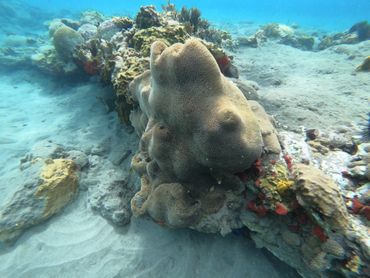
Is there a future for artificial reefs?
Dutch Caribbean Nature Alliance (DCNA), Naturalis Biodiversity Center, University of GroningenCoral reefs are visually very aesthetic, but above all they play a central role in the ocean. Coral reefs support over 800,000 marine species and supply numerous ecosystem goods and services. Yet sadly, corals are threatened by a combination of global climate change and local human activities such as fishing, shipping and coastal development. Natural recovery is too slow, so active restoration efforts are crucial to prevent the loss of our coral reefs.
Corals under threat

Filling this gap, a team of researchers explored the biodiversity of urban structures at St. Eustatius, an island of the Caribbean Netherlands. Their findings are published in the scientific journal Marine Pollution Bulletin. The team consists of Claudia Hill from the University of Groningen and Myrsini Lymperaki from the University of Amsterdam, under the supervision of professor Bert Hoeksema, who is affiliated with Naturalis Biodiversity Center and the University of Groningen.
A new home for marine life
The island of St. Eustatius, popularly known as ‘Statia’, is located in the eastern Caribbean and is a special municipality of the Netherlands. The island is steeped in history, having changed hands between numerous European empires and having thrived as a port of trade in the 17th and 18th century. Today St. Eustatius is much quieter, though traces of the past like remnants of ancient piers and jetties remain in the coastal water. “These ancient structures shelter a new home for marine life”, tells Claudia Hill, first author of the article. “With corals and other benthos living on the remains, altogether forming an artificial reef”, she continues.
Artificial versus natural reef

“What I personally found most surprising, is despite the artificial reef being centuries old, the cover and abundance of reef organisms is still not comparable to that on the natural reef”, says Hill. “But it is important to note, that whilst the artificial reef did not host an identical community to the natural reef, it still serves as a healthy and diverse reef in its own right”, she continues. Therefore, there is still a place for artificial reefs in conservation work, as they serve to enhance the marine life of the local area. “Artificial reefs provide a promising outlook for the future of coral reefs, yet a precautionary approach must be taken to prevent any unwanted consequences, such as the invasion of non-native species.”
More information
- Curious about further details of this study? Read the full publication in Marine Pollution Bulletin.
- For further details about the study, please contact Bert Hoeksema and Claudia Hill.
Text: Claudia Hill, University of Groningen, Naturalis Biodiversity Center
Photos: Naturalis Biodiversity Center
